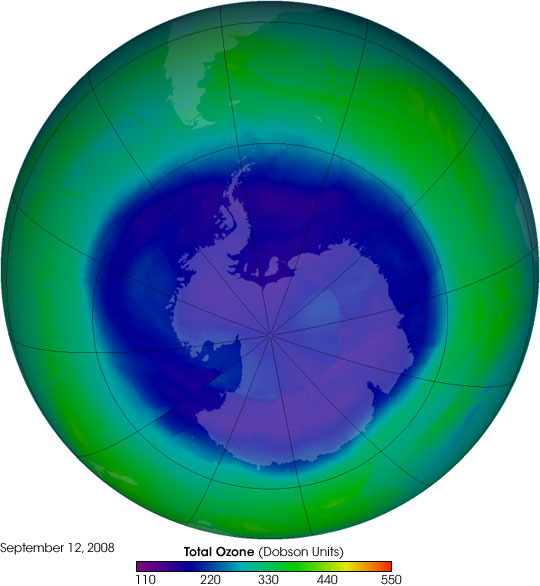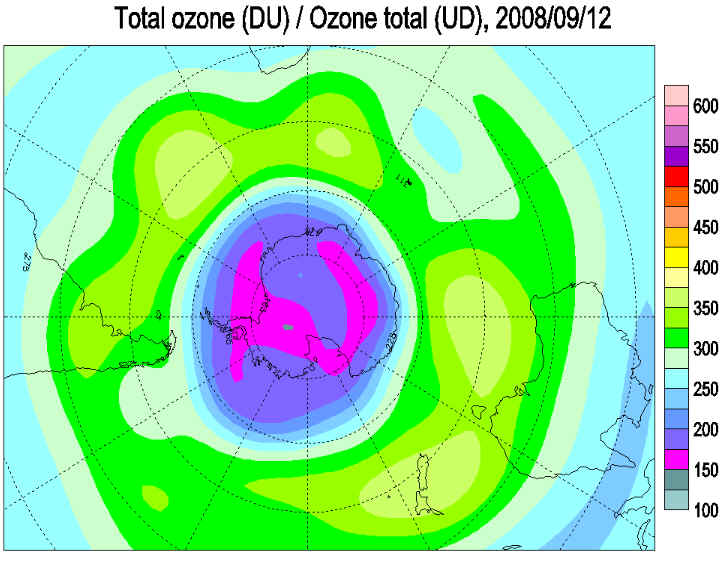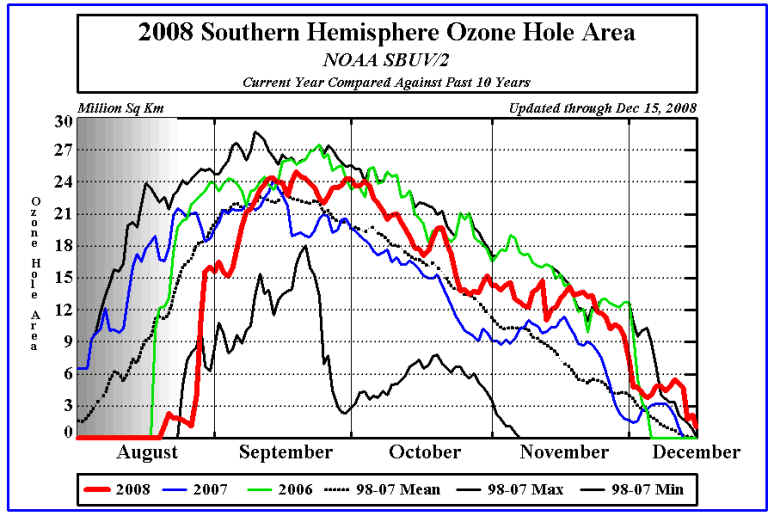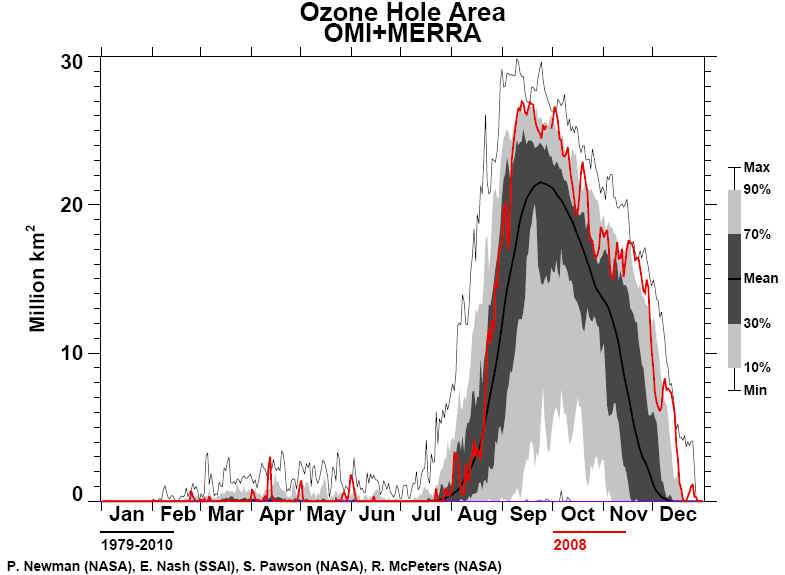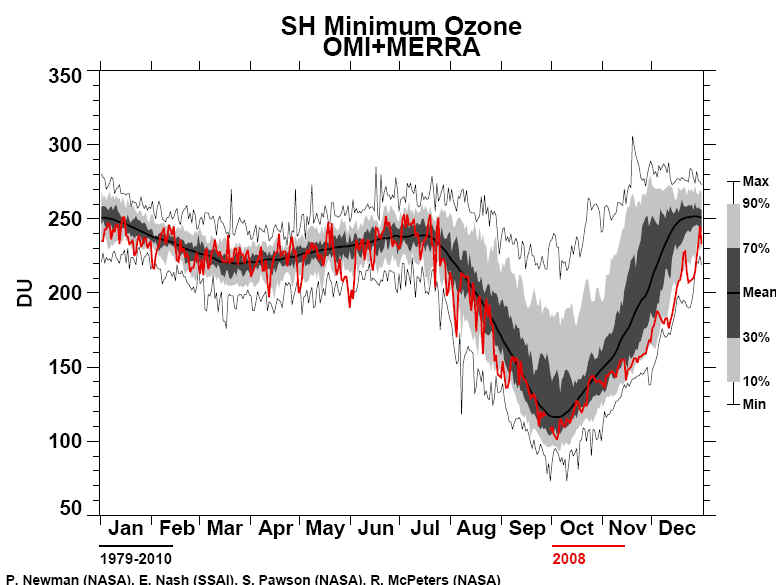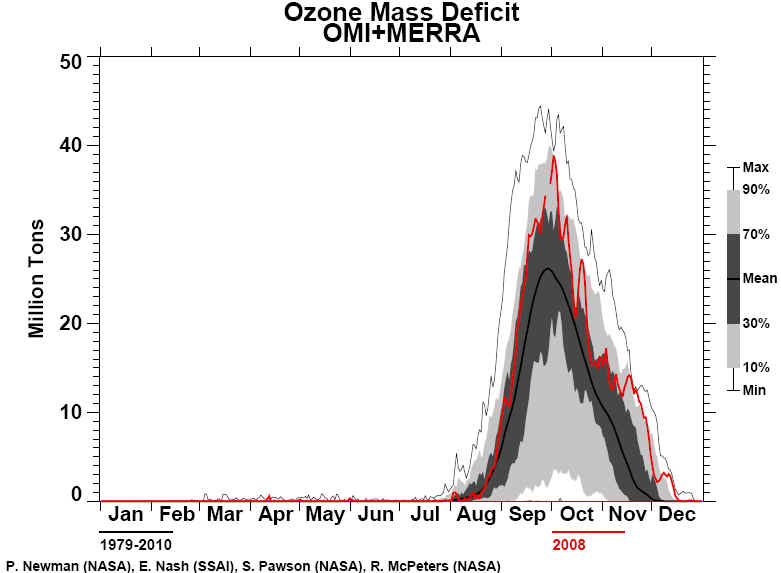|
Ozone Hole 2008
http://ozonewatch.gsfc.nasa.gov
October 31
2008 NASA-The Antarctic ozone hole reached its annual maximum on Sept. 12,
2008, stretching over 27 million square kilometers, or 10.5 million square
miles. The area of the ozone hole is calculated as an average of the daily
areas for Sept. 21-30 from observations from the Ozone Monitoring
Instrument (OMI) on NASA’s Aura satellite.
2008 ozone hole larger than last year 7 October 2008 ESA-The 2008
ozone hole – a thinning in the ozone layer over Antarctica – is larger
both in size and ozone loss than 2007 but is not as large as 2006. Ozone is a protective
atmospheric layer found in about 25 kilometres altitude that acts as a
sunlight filter shielding life on Earth from harmful ultraviolet rays,
which can increase the risk of skin cancer and cataracts and harm marine
life. The depletion of ozone is caused by extreme cold temperatures at high altitude and the presence of ozone-destructing gases in the atmosphere such as chlorine and bromine, originating from man-made products like chlorofluorocarbons (CFCs), which were phased out under the 1987 Montreal Protocol but continue to linger in the atmosphere. Depending on the weather conditions, the size the Antarctic ozone hole varies every year. During the southern hemisphere winter, the atmosphere above the Antarctic continent is kept cut off from exchanges with mid-latitude air by prevailing winds known as the polar vortex – the area in which the main chemical ozone destruction occurs. The polar vortex is characterized by very low temperatures leading to the presence of so-called stratospheric clouds (PSCs). As the polar spring arrives in September or October, the combination of returning sunlight and the presence of PSCs leads to a release of highly ozone-reactive chlorine radicals that break ozone down into individual oxygen molecules. A single molecule of chlorine has the potential to break down thousands of molecules of ozone. Julian Meyer-Arnek of the German Aerospace Centre (DLR), which monitors the hole annually, explained the impact of regional meteorological conditions on the time and range of the ozone hole by comparing 2007 with 2008. "In 2007 a less concentric and larger polar vortex led to an early onset of the ozone destruction in the sunlit parts of the polar vortex," Meyer-Arnek said. "Therefore, we saw an ozone hole formation in the beginning of September 2007 which corresponded to the average behaviour of the years 1995-2006." "In 2008 a more concentric polar vortex led to a delay of the onset of the ozone destruction of about one week. The preconditioning of the polar chemistry was about the same for both years, although in 2008 the temperatures were slightly below the 2007 temperatures leading to slightly improved formation of PSCs," he continued. "Since the polar vortex remained undisturbed for a long period, the 2008 ozone hole became one of the largest ever observed." Minimum values of the ozone layer of about 120 Dobson Units are observed this year compared to around 100 Dobson Units in 2006. A Dobson Unit is a unit of measurement that describes the thickness of the ozone layer in a column directly above the location of measurement. DLR’s analysis is based upon the Scanning Imaging Absorption Spectrometer for Atmospheric Cartography (SCIAMACHY) atmospheric sensor onboard ESA’s Envisat, the Global Ozone Monitoring Experiment (GOME) aboard ESA’s ERS-2 and its follow-on instrument GOME-2 aboard EUMETSAT’s MetOp. Scientists say that since the size and precise time of the ozone hole is dependent on the year-to-year variability in temperature and atmospheric dynamics, the detection of signs of ozone recovery is difficult. "In order to detect these signs of recovery, a continuous monitoring of the global ozone layer and in particular of the Antarctic ozone hole is crucial," Meyer-Arnek said
http://www.cpc.ncep.noaa.gov/products/stratosphere/sbuv2to/ozone_hole.shtml
Situation at 2008 November 21British Antarctic Survey Ozone BulletinThe 2008 ozone hole season is past its peak and ozone levels over Antarctica are slowly rising, with the ozone hole slowly shrinking. The polar vortex has been very stable throughout the season, however the final spring warming is expected towards the end of the month. During its initial stages, the ozone hole was much smaller than has been usual for August, but it grew rapidly as stratospheric clouds were exposed to sunlight. It covered over 25 million square kilometres in mid September, about the same as last year and remained at around 24 million square kilometres until early October. It is now around 14 million square kilometres, which is the largest on record for this time of year. The temperature of the ozone layer over Antarctica is rising as the spring warming takes hold, and is now generally too warm for polar stratospheric clouds (PSCs) to continue to exist. The temperature within the polar vortex is generally a little below the normal. Ozone values are above 350 DU in parts of the circum-polar regions, which is a bit lower than at this time last year. Lowest values, near 160 DU, are offset slightly from the pole towards the Weddell Sea. The vortex briefly showed a more elliptical circulation pattern, and the ozone hole extended over the tip of South America, the Falkland Islands and South Georgia between October 28th and 30th. PSCs were seen from Rothera on several occasions and also at Halley. Situation at 2008 November 13 British Antarctic Survey Ozone BulletinThe 2008 ozone hole season is past its peak and ozone levels over Antarctica are slowly rising, with the ozone hole slowly shrinking. During the initial stages, the ozone hole was much smaller than has been usual for August, but it grew rapidly as stratospheric clouds were exposed to sunlight. It covered over 25 million square kilometres in mid September, about the same as last year and remained at around 24 million square kilometres until early October. It is now around 14 million square kilometres, which is larger than it was at this time in 2007. The temperature of the ozone layer over Antarctica is rising from the winter minimum as the spring warming takes hold, but some areas are still cold enough for polar stratospheric clouds (PSCs) to continue to exist. PSCs were seen from Rothera on several occasions and also at Halley. Ozone values are above 350 DU in parts of the circum-polar regions, which is a bit lower than at this time last year. Lowest values, near 150 DU, are over Dronning Maud Land. The temperature within the polar vortex is generally a little below the normal. The vortex briefly showed a more elliptical circulation pattern, and the ozone hole extended over the tip of South America, the Falkland Islands and South Georgia between October 28th and 30th. Situation at 2008 October 28 British Antarctic Survey Ozone BulletinThe 2008 ozone hole season is past its peak and ozone levels over Antarctica are rising. During the initial stages, the ozone hole was much smaller than has been usual for August, but it grew rapidly as stratospheric clouds were exposed to sunlight. It covered over 25 million square kilometres in mid September, about the same as last year and remained at around 24 million square kilometres until early October. It is now around 16 million square kilometres, which is larger than it was at this time in 2007 . The temperature of the ozone layer over Antarctica is beginning to rise from the winter minimum, but some areas are still cold enough for polar stratospheric clouds (PSCs) to continue to form. PSCs were seen from Rothera on several occasions and also at Halley. Ozone values are above 400 DU in parts of the circum-polar regions, which is a bit lower than at this time last year. Lowest values, near 150 DU, are over Dronning Maud Land. The temperature within the polar vortex is generally a little below the normal. The vortex has begun to show a more elliptical circulation pattern, and the ozone hole is expected to extend over the tip of South America, the Falkland Islands and South Georgia between the 28th and 31st. Situation at 2008 October 23British Antarctic Survey Ozone BulletinThe 2008 ozone hole season is past its peak and ozone levels over Antarctica are rising. During the initial stages, the ozone hole was much smaller than has been usual for August, but it grew rapidly as stratospheric clouds were exposed to sunlight. It covered over 25 million square kilometres in mid September, about the same as last year and remained at around 24 million square kilometres until early October. It is now around 20 million square kilometres, which is larger than it was at this time in both 2006 and 2007 . The temperature of the ozone layer over Antarctica is beginning to rise from the winter minimum, but is still cold enough for polar stratospheric clouds (PSCs) to continue to exist. PSCs were seen from Rothera on several occasions and also at Halley. Ozone values are above 400 DU in parts of the circum-polar regions, which is a bit lower than at this time last year. Lowest values, near 130 DU, are over the Weddell Sea. The temperature within the polar vortex is generally a little below the normal and it is showing a relatively simple circulation pattern, with few excursions over extra-polar regions.
Situation at 2008 October 15British Antarctic Survey Ozone BulletinThe 2008 ozone hole season is past its peak and ozone levels over Antarctica are rising. During the initial stages, the ozone hole was much smaller than has been usual for August, but it grew rapidly as stratospheric clouds were exposed to sunlight. It covered over 25 million square kilometres in mid September, about the same as last year and remained at around 24 million square kilometres until early October. It is now around 18 million square kilometres, which is larger than it was at this time in 2007 . The temperature of the ozone layer over Antarctica is beginning to rise from the winter minimum, but is still cold enough for polar stratospheric clouds (PSCs) to continue to exist. They were seen from Rothera on several occasions and also at Halley. Ozone values are above 400 DU in parts of the circum-polar regions, which is a bit lower than at this time last year. Lowest values, near 120 DU, are over Dronning Maud Land. The temperature within the polar vortex is generally a little below the normal and it is showing a relatively simple circulation pattern, with few excursions over extra-polar regions. Situation at 2008 October 2British Antarctic Survey Ozone BulletinThe 2008 ozone hole season is near its peak. Ozone levels over Antarctica continue to drop as stratospheric clouds are exposed to sunlight. During the initial stages, the ozone hole was much smaller than has been usual for August, but it grew rapidly and covered over 25 million square kilometres in mid September, about the same as last year. It remains at around 25 million square kilometres, and is larger than it was in 2006 or 2007 in late September. The temperature of the ozone layer over Antarctica is beginning to rise from the winter minimum. Polar stratospheric clouds (PSCs) continue to form and they have been seen from Rothera on several occasions and also at Halley. Ozone values are above 400 DU in parts of the circum-polar regions, which is a bit lower than at this time last year. Lowest values, below 120 DU, are over central Antarctica. The temperature within the polar vortex is generally a little below the normal and it is showing a relatively simple circulation pattern, with few excursions over extra-polar regions. Situation at 2008 September 24British Antarctic Survey Ozone Bulletin The 2008 ozone hole season has begun, and as sunlight returns to Antarctica ozone levels are dropping as more stratospheric clouds are exposed to sunlight. During the initial stages, the ozone hole was much smaller than has been usual for August, but it has grown rapidly and covered over 25 million square kilometres in mid September, about the same as last year. It is now probably shrinking. The temperature of the ozone layer over Antarctica is near its lowest of the winter. Polar stratospheric clouds (PSCs) continue to form and they have been seen from Rothera on several occasions and also at Halley. Ozone values are above 350 DU in parts of the circum-polar regions, which is a bit lower than at this time last year. Lowest values, below 130 DU, are over the Weddell Sea, perhaps triggered by extensive PSC formation as stratospheric air passes over the Antarctic Peninsula. The temperature within the polar vortex is generally a little below the normal and it is showing a relatively simple circulation pattern, with few excursions over extra-polar regions.
|
||||||||||||||||||||||||

